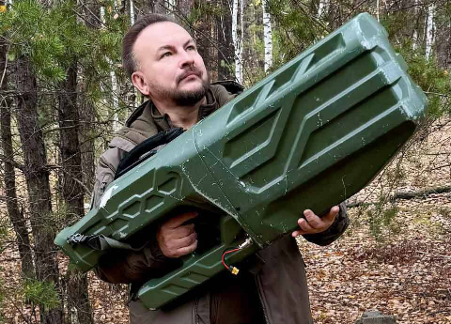A video published on social media by the pro-Moscow military journalist Andrey Medvedev on Wednesday shows for the first time Russian troops deploying their version of a thermite carrying first-person view (FPV) “dragon drone.”
The video shows a soldier from Russia’s “Omut Group” UAV unit attaching a canister which resembles the thermite sub-munition from an artillery round to a quadcopter drone before launching it, allegedly toward a Ukrainian position.
JOIN US ON TELEGRAM
Follow our coverage of the war on the @Kyivpost_official.
The video then intercuts between the operator’s view of the drone flying over a tree line and a third-party drone’s view of it dispensing the burning substance, supposedly above a Ukrainian defensive position.
Compared with the earlier videos of the Ukrainian dragon drones in action, such as those posted on Kyiv Post on Sept. 4 and Sept.8, this Russian version is underwhelming. Rather than Kyiv’s “fire spewing drones” the Moscow version emits a dribble of sparks that seem to cause very little, if any, real damage.
A post on the Ukrainian “Brothers in Arms” Telegram channel said: “Just another reminder that the enemy learns very quickly. They have already copied our dragon drone and are now burning our positions,” a view that, from what we have seen, is currently an overstatement.

Keith Kellogg and Trump’s Russia – Ukraine Peace Plan
Whereas another pro-Kyiv milblogger “Sofa Assault Brigade” commented that “the Russians are quickly copying and learning, and the battlefield is increasingly resembling a drone war.”
After the spectacular videos showing Ukrainian dragon drones in action, it should be no surprise that Russia is now trying to develop its own version. The war in Ukraine has been a two-and-a-half-year crucible for the development of weapons and tactics, with each side (and the outside world) learning from each other, especially in the use of drones on air, sea and land.
Ten days ago, Ukraine’s “Landmines and Coffee” posted three minutes worth of video that documented a Russian attempt to replicate dragon fire using the thermite elements from a Soviet-era 3VZ4 (3BЗ4)120mm incendiary mortar.
After flying the drone around “dry” for a couple of minutes, a separate video shows the effect of the drone after igniting the thermite charge. While the flame is more impressive than the Omut demo, it still seems ineffective. Even though the drone is only hovering a couple of meters off the ground, a shower of sparks and a few globules of burning thermite fall to the ground igniting small fires when they land. The video ends with the drone rising a few more meters before crashing to the ground in flames.
But the Russians’ dragon drones are still in their early days. It should be anticipated that they will eventually get the thing to work as intended.
Thermite is readily available in the arsenals of both Ukraine and Russia in the form of grenades, artillery shells and engineering cutting charges. According to Human Rights Watch both sides have used thermite munitions to attack personnel, facilities and materiel during the war in Ukraine.
The Ukrainian start-up company Steel Hornets produces a number of thermite charges designed to be delivered by drones ranging in size from 0.5 to 2.5 kg (1.1 to 5.5 pounds). Thermite consists of a mix of powdered iron oxide and aluminum that burns at about 2400 degrees Celsius (4,400 Fahrenheit) or more.
The aim of the dragon drone attacks is to use the flamethrower effect that thermite can create to ignite tree lines, foliage and other flammable material such as camouflage netting that provides cover for troops
While the “dragonfire” itself is unlikely to cause much direct injury unless an individual is unfortunate enough to be struck by a burning fragment, it will ignite any flammable material from where the flame and smoke will choke the occupants, forcing them out of cover and possibly exposing them for follow-up artillery or conventional kamikaze drone attack.
The ingenuity and innovation that this new development represents has captured the attention of the world not only because of the references to the HBO TV series “Game of Thrones,” but especially because of the weapon’s potential effectiveness. No doubt that it will lead other militaries to use and further develop the concept.
You can also highlight the text and press Ctrl + Enter






